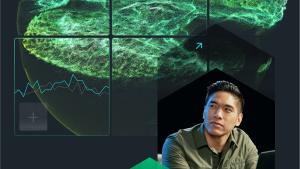In the process of modernizing your software stack—adopting technologies like cloud services, containers, service fabrics, and so on—it can be tempting to focus on monitoring those new parts instead of the customer experience you’re delivering. But your customers don't care how you build and provide your software. They just care that it works and that it works well.
Unfortunately, this simple maxim can get lost in the day-to-day details (and, at times, chaos) of modern software development and operations. To help maintain focus on what really matters, we've built the New Relic platform around six core principles that we believe define the role of monitoring in a modern enterprise. We work every day to ensure our platform—via the products and features we ship—adheres to these principles, so you can continue to delight your customers.
1. The application is what matters to your customers.
When you assess your priorities for monitoring your technology stack, remember that the only thing your customers see, and thus the only thing they care about, is the performance of the application they’re using. Whatever may be happening in your stack, the application is where the rubber meets the road.
This customer-centric mindset is baked into New Relic’s DNA. It’s why we’ve created a broadly deployable APM solution that eliminates manual instrumentation of your applications, and provides a deep, interconnected instrumentation of your customer experience. The customer-centric mindset is why we support 8 languages and more than 200 programming frameworks that give you highly granular visibility into your apps. And it’s why more than 3 million websites are monitored with New Relic Browser, for example, representing 7% of the top 1,000 sites on the internet.
To ease the transition from the architecture you have to the one you want to have, we believe that you need deep and broad tracing to contend with complex hybrid environments. We believe that your teams need tools that help them quickly find a needle in a haystack—or in several haystacks—during an outage, and that's why we offer analytics on highly granular event data at scale (ingesting two billion data points and querying more than a trillion data points every minute).
2. True Software-as-a-Service shouldn’t require any work on your part.
Modern software teams should spend their time writing code or maintaining customer critical software, not performing toilsome and repetitive tasks. Monitoring should empower teams, not weigh them down.
Only a true software-as-a-service (SaaS) architecture can make that happen.
Just as important, you can't monitor auto-scaling environments in the cloud unless your monitoring platform can scale at the same time. On-premise, single-tenant, and hosted architectures simply can't deliver that. You need to keep your team focused on delivering value to customers, not scaling a monitoring platform. You have bigger fish to fry.
The benefits of a true multi-tenant SaaS architecture go far beyond not having to buy servers to scale your monitoring. A true SaaS solution, such as New Relic, helps you avoid the worry, hassle, and expense of maintaining, updating, and managing the dedicated infrastructure needed to monitor your apps. Instead of forcing you to install patches and upgrades like some single-tenant hosted solutions, we automatically roll out our innovations to our users.
We released more than 170 new features last quarter—to all of our customers. We would not have been able to do that without our true SaaS delivery model. And because we’re multi-tenant, we can help you capture and analyze the data you find most critical and produce real intelligence features on top of it.
3. A modern monitoring platform should focus on modern software.
Increasing numbers of our customers are actively engaged in a tectonic shift away from legacy, monolithic application architectures toward the exploration and embrace of modern technologies and practices: cloud computing, DevOps, CI/CD, containers, serverless, and more.
Not coincidentally, New Relic’s customers are ahead of the game when it comes to adopting cutting-edge software development methods. A typical New Relic customer, for example, has migrated 43% of its applications into the cloud, compared to a 10% average migration for their industry peers. When it comes to serverless and containers, a quarter of New Relic customers use AWS Lambda, and two-thirds use Docker. And nearly half of our largest customers deploy more than 10 times a month
Clearly, a modern application monitoring platform has to embrace and complement these trends. That’s why the New Relic platform offers app-centric visibility into more than 50 cloud services, including Kubernetes, Docker, and Amazon Web Services serverless products, like AWS Lambda.
Of course, we still offer a ton of support for "legacy" frameworks and technologies, and we support ingestion of data from a wide variety of other sources to help you weather the transition to modern architectures. But the vast majority of our focus is on modern technologies, because that's where we believe our customers want to go.
4. Your teams need intelligence and analytics to find and fix issues fast.
In today’s complex technology environments, an outage or performance problem is like looking for a needle in multiple haystacks—all while the clock is ticking on potential—possibly significant—revenue losses. A modern APM platform must help to minimize these threats to your revenue and your customer experience. You need timely and targeted intelligence that can help you determine where the error is coming from, and then help you isolate and fix it as quickly as possible.
To that end, the New Relic platform—including New Relic Insights and the New Relic Query Language (NRQL)—offers what we believe are the most flexible, powerful, and rigorous baseline alerts in the industry: Define any KPI, and get instant intelligence on what’s normal—and what’s not—in your application stack.
Many cutting-edge New Relic capabilities support this effort. Root-cause analysis on alerts shows your developers and operations engineers exactly where the problem is—even if it lies in another system. Outlier detection, meanwhile, illustrates where performance is deviating from normal, and provides feedback on what to fix. And intelligent error profiles give you visibility into your application errors so you can more easily identify what’s causing them. Finally, get real-time, personalized recommendations on infrastructure scaling, outliers, performance issues, and much more via radar cards.
5. Your monitoring platform must be open and extensible.
In order to work as fast and confidently as possible, DevOps teams need to get data in and out of their APM platform, and integrate it with their team’s existing workflows and processes. So, over the past decade, as we’ve expanded the New Relic product portfolio, our platform has become more extensible. That movement culminated at FutureStack18: San Francisco with the announcement of the New Relic Developer Program—A Journey Towards Openness, Simplification, and Engagement.
Our aim is to offer a complete set of APIs, covering data coming into our platform and data going out of our platform, in ways that support your existing workflows. That is, you should be able to deploy a new dashboard or alert template as part of an app's source code, not as an aftermarket add-on.
Additionally, we have customers who build their runbooks around New Relic. In a true DevOps culture, monitoring should be codified just like any other process, especially for modern software teams that need to move fast.
Need even more extensibility? New Relic offers SDKs that let you build your own integrations and integrate them with custom frameworks or services. It’s all part of what we consider the best developer platform in our industry, and it lets you share best practices and build on top of the New Relic platform with a community of more than 110,000 users.
6. Your teams need a monitoring platform that is easy to adopt and implement—bolstered with world-class support.
Even the most powerful monitoring platform isn’t much good if it doesn’t get used. That’s why we take advantage of our SaaS-native architecture to make New Relic easy to learn, quick to install, and intuitive to use. We operate at tremendous scale, and some of the world’s largest and most closely regulated companies trust us to maintain a reliable and highly available APM platform with room to accommodate their busiest days.
We offer enterprise-level official support and scale. Our ease of adoption and ease of use is demonstrated via our ongoing commitment to helping our customers get value fast: Deploy the agent, and start getting visibility in minutes.
Our product team has extensive experience managing this, and we share our learnings in the form of FutureTalks and in a wide variety of presentations at industry events, online technical content—including the New Relic blog—and many other channels. Just as important, we support public forums and communities—including our new Developer Program—to encourage legions of New Relic customers to share their best practices with others.
We back it all up with a growing Global Customer Solutions and Success Group that boasts centuries of cumulative experience in monitoring and a solutions-centric rollout approach. To make sure you can get support when you need it, we offer 24/7/365 support, dedicated Customer Success Managers, and 1-to-3-hour SLAs for responding to support tickets and issues.
The bottom line
If you're pursuing a monitoring strategy and choosing a monitoring platform, you need to ask yourself: “Are we addressing these six core principles?” If not, your teams could suffer; your customers could suffer; and, in the end, your business could suffer.
Remember, your customers don't care what new hotness you’ve built into your technology stack. They don’t care how often you deploy new software, or even how well your teams deal with incidents and outages. They just want your online products and services to deliver a consistently great experience. If you don’t deliver it, your competitors surely will.
Les opinions exprimées sur ce blog sont celles de l'auteur et ne reflètent pas nécessairement celles de New Relic. Toutes les solutions proposées par l'auteur sont spécifiques à l'environnement et ne font pas partie des solutions commerciales ou du support proposés par New Relic. Veuillez nous rejoindre exclusivement sur l'Explorers Hub (discuss.newrelic.com) pour toute question et assistance concernant cet article de blog. Ce blog peut contenir des liens vers du contenu de sites tiers. En fournissant de tels liens, New Relic n'adopte, ne garantit, n'approuve ou n'approuve pas les informations, vues ou produits disponibles sur ces sites.



